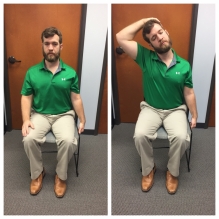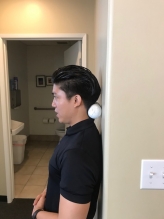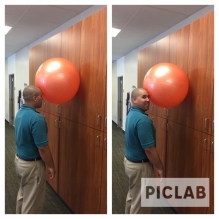It’s common to experience neck pain after shoulder surgery. Even though the primary area of pain may be located in the shoulder near the surgical site, you can also have pain in the neck as you recover from surgery. This pain in the neck can be caused by the anesthesia, the positioning of the neck during surgery, and simple overuse of the muscles between the neck and the shoulder.
Neck pain after shoulder surgery can become debilitating and keep you from living your life to its fullest extent. If it gets to the point that it impedes the recovery of your shoulder surgery then it can be a serious issue.
However, there are some simple steps, tips, and exercises that may help alleviate neck pain after shoulder surgery.
Is Neck Pain Common After Shoulder Surgery?
 The neck is under a lot of stress during shoulder surgery. The neck has to support the head, align with the spine while keeping tension on the neck muscles between shoulder movements.
The neck is under a lot of stress during shoulder surgery. The neck has to support the head, align with the spine while keeping tension on the neck muscles between shoulder movements.
After shoulder surgery, it is quite common for someone to experience neck pain. This neck pain may last for a few days or it can last up to weeks if it isn’t addressed quickly. Post-surgery, there is a shoulder sling that pulls on the side of the neck muscles, poor sleeping positions, and compensations for weak muscles after surgery.
Is There a Way to Prevent Neck Pain After Shoulder Surgery?
There are several simple steps you can take in order to prevent neck pain after shoulder surgery including:
- Trying to find a comfortable sleeping position. After shoulder surgery, you typically have to sleep in a recliner or on your back to avoid putting pressure on the operated shoulder.
- Keeping the neck in proper alignment as you heal from shoulder surgery; posture can make a huge difference in preventing neck pain flare-ups
- Make sure that the shoulder post-op brace is well adjusted and provides adequate support for your shoulder so that your neck muscles aren’t doing all the work
- Stay active with walking and moving as much as you can tolerate. Sitting and being sedentary can make your neck pain worse
- Neck exercises and neck stretches can be helpful in alleviating neck pain after shoulder surgery
Common Causes of Neck Pain After Shoulder Surgery
There are many different reasons for having neck pain after shoulder surgery even though the neck wasn’t directly involved during the operations. This includes what your neck was doing during surgery, overcompensations immediately after surgery, and muscle tightness that follows as your shoulder heals.
Shoulder Sling Issues
Most patients will have to wear a brace after shoulder surgery to immobilize the shoulder and protect the repair. While this is helpful for the shoulder, it can actually aggravate neck pain because of where the strap places pressure on the side of the neck. This means that all of the stress to hold up your shoulder is on your neck muscles which tend to tighten up.
It’s important to ensure that your sling fits correctly and provides enough support on the shoulder but doesn’t put too much stress on the neck muscles. Be sure to learn how to adjust your brace because it will undoubtedly get loose and need to be adjusted throughout the recovery.
Positioning of the Neck During Shoulder Surgery
Some surgeries may require that the neck be placed in a certain position to allow easier shoulder access for surgery. This may mean that your neck was cranked to the side for quite a while. This obviously can cause neck pain after shoulder surgery due to the stress on the vertebrae and muscles over the time it took for the surgery.
You won’t be able to stop this because you will be under anesthesia and can’t tell the doctors to adjust the position of the neck.
When you get out of surgery your neck might be sore and stiff for up to 3-4 weeks after shoulder surgery simply from the positioning during surgery.
Overuse of the Upper Trap Muscles
The upper trap muscles are located on both sides of the neck. They attach at the base of the skull and go all the way down to the top of the shoulder. This muscle helps move the neck but it also helps lift the shoulder upward.
After shoulder surgery, the muscles of the shoulder won’t work as well. The body will look for ways to still get tasks completed and the upper trap muscle will overcompensate. This muscle will help lift the shoulder more than it should and tends to get overworked in the first few weeks.
Working to improve your shoulder strength and reduce the stress on the upper trap can be helpful in reducing neck pain.
Muscle Guarding and Shoulder Spasms After Surgery
Muscle guarding is a very common problem that occurs after shoulder surgery. It happens to protect the shoulder and allow it to heal. These spasms can pull and affect the neck muscles making them uncomfortable for days up to a few weeks.
Shoulder spasms can be an issue if your neck is very tight post-surgery and it starts pulling on the neck muscles which causes them to tighten up even more.
This constant tension in the neck muscles can cause pain if the tightness is relieved or modified. It’s important for you to keep these muscles loose by stretching them regularly and avoiding aggravating activities that may trigger spasms.
Exercises to Help With Neck Pain After Shoulder Surgery
There are many different exercises that you can do to help with neck pain after shoulder surgery. We’ve selected some easy exercises to do with a sling on and are safe to do with a healing shoulder after surgery.
Upper Trap Stretch
This upper trap neck stretch will help relieve neck tension and muscle spasms. This exercise is great for stretching the upper trap muscles to take some of the stress off your neck muscles.
Start by sitting up straight. Take your non surgical hand and rest it on your head. Use this hand to pull your head away from the surgical shoulder bringing the ear to the opposite shoulder. Keep this position for 30 seconds then rest. Repeat three times.

Ball Trigger Point Release
If you have neck pain after shoulder surgery and it’s originating from the neck muscles, this exercise will help. You can do this anywhere by lying down or sitting up in a chair with your head on trigger point release balls, a tennis ball, or a racquetball.
You’ll be rolling around to find tight spots along your neck muscles but they are usually located at the base of the neck where it meets with your shoulder.
Once you find a tight spot, hold that position for 20-30 seconds then move to another area until all areas are done. This is one of the most effective exercises for neck pain after shoulder surgery due to its ability to target muscle tension in multiple locations along the neck muscles. You can do this exercise for up to five minutes.

Neck Swiss Ball Rotations on the Wall
Swiss ball neck rotations are great for strengthening the neck muscles and also helps stretch them out. This exercise is very easy to do in your own home with a Swiss Ball or any other type of gym equipment that you can find at most gyms or fitness centers.
Start by standing next to a wall. Place the swiss ball on the wall and rest your head on the ball holding it against the wall. With applying pressure through your neck, rotate the ball side to side stretching the neck and working the muscles at the same time.
This exercise is recommended to do it facing forward and doing it facing backward as this will work different muscles and help relieve different areas of tightness.

Other Tips to Decrease Neck Pain After Shoulder Surgery
Besides stretching and mobility exercises, there are other things that you can do you try and help decrease your neck pain until your shoulder is strong enough to reduce your compensation and overload the neck.
Use a Theracane on the Upper Trap Muscle
The neck is the area most people struggle with because it’s hard to reach all those muscles on your own. Using a Theracane can be helpful in reaching some of these neck areas that you normally couldn’t do yourself
You can use it with one arm and can even use it with a sling on. It’s safe to use on certain muscles right after surgery which makes it a great option to stop neck pain early on in the recovery.
Apply a Hot Pack on the Neck
You can use a neck hot pack to help reduce neck pain and muscle tension. This is another great option for early on in the recovery process or when you need some extra relief from neck pain after the shoulder surgery.
This will also loosen up your neck muscles which makes it easier to stretch them out later. Make sure that you follow the instructions of whatever type of neck hot pack that you decide to use.
Try a Neck Pillow For a Different Sleeping Position
In order for neck pain to be as minimal as possible, finding a comfortable sleeping position is imperative.
A lot of the time after shoulder surgery you’ll have to sleep sitting upright or in a recliner. This can be tough on the neck and leave you with neck pain. We recommend using a cervical pillow to help keep the neck in alignment and it can transfer between a recliner and the bed easily.
Apply Kinesiotape on the Upper Trap Muscle
Using Kinesio tape to help support neck muscles can be a great option for people who are looking for other ways to stop neck pain. It’s easy to put on and is very flexible so it allows you to move your neck around almost normally while wearing the tape.
You don’t have to worry about having someone else apply this neck tape for you and it can be worn all day under your clothes. It can survive the shower and lasts from anywhere from 3-5 days for each use.
Be Mindful of your Posture
Finally, one of the most important tips is to be mindful of your posture. A lot of people aren’t aware that neck pain can actually come from bad postures so it’s imperative to pay attention to which factors contributed most to neck pain development.
This particularly important after a shoulder surgery includes sitting up straight, avoiding your neck going too far forward, avoiding sitting for too long in one position, and being sure that the shoulder sling doesn’t pull you into a slouched position.
Conclusion
That’s it for neck pain after shoulder surgery. We hope that this article was helpful and provided a lot of information on neck pain in general as well as exercises to try out when you have neck pain from shoulder surgery or other causes.
As you recover from shoulder surgery, it’s important that you focus on your shoulder recovery and don’t have to suffer through neck pain at the same time.
Other Great Rehab Related Articles
How to Stay Active After Cervical Fractures: Expert Tips and Advice
Dealing with Painful Stairs After Ankle Replacement Surgery
Walking After a Total Ankle Replacement: Tips for a Successful Recovery
Exercises While Non-Weight Bearing After Ankle Replacement: Elevation, AROM, Leg Raises, and More
Ankle Pain with Stairs: Causes and Home Treatment Options
5 Common Mistakes You’re Making After an Ankle Sprain
Disclaimer: The information provided in this post is for educational purposes only. This is not a substitute for a medical appointment. Please refer to your physician before starting any exercise program.









